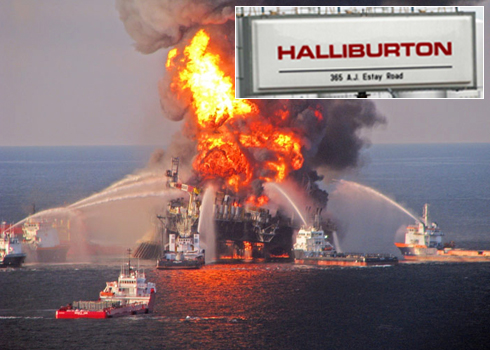Halliburton is back.
The Houston energy services giant once led by Dick Cheney became the corporate bête noire of the Bush years as one of the biggest (and most troubled) Iraq War contractors. But the company had largely faded from public view since President Obama entered office — until now.
As the provider of crucial cementing services on the oil rig that exploded and set off the massive spill in the Gulf, Halliburton finds itself under scrutiny once again.
While the company says it had just four employees on the rig at the time of the April 20 explosion — out of a total crew of 126 — journalists and Congressional investigators are taking a close look at the possible role of cementing in the accident.
The Wall Street Journal last week highlighted the possible role of cementing in the April 20 accident:
In the case of the Deepwater Horizon, workers had finished pumping cement to fill the space between the pipe and the sides of the hole and had begun temporarily plugging the well with cement; it isn’t known whether they had completed the plugging process before the blast.
Regulators have previously identified problems in the cementing process as a leading cause of well blowouts, in which oil and natural gas surge out of a well with explosive force. When cement develops cracks or doesn’t set properly, oil and gas can escape, ultimately flowing out of control.
[TPM SLIDESHOW: Fire In The Gulf: New Pictures Of The Deepwater Horizon]
Others have dug up a 2007 Minerals Management Services study that found “cementing problems were associated with 18 of 39 [oil rig] blowouts between 1992 and 2006.”
(For more on how cementing works, check out this Los Angeles Times piece.)
Rep. Henry Waxman, chair of the House Energy and Commerce Committee, has requested Halliburton CEO David Lesar appear at a hearing on the spill next week. He and Rep. Bart Stupak, chair of the investigations subcommittee, fired off a letter (.pdf) to Halliburton demanding all documents relating to “the explosion at the Deepwater Horizon rig; the possibility or risk of an explosion or blowout at the Deepwater Horizon rig; and the status, adequacy, quality, monitoring, and inspection of the cementing work related to the Deepwater Horizon rig.”
And on Tuesday, a Halliburton vice president joined BP and Transocean execs for a closed-door briefing with lawmakers on the Hill.
Meanwhile, the company has already been named in several class action suits brought by groups, like shrimpers, seeking damages for losses expected from the spill.
Halliburton, for its part, released a statement April 30 saying that, at the time of the accident, it “had completed the cementing of the final production casing string in accordance with the well design approximately 20 hours prior to the incident. The cement slurry design was consistent with that utilized in other similar applications. ”
And the company’s website currently features a large graphic trumpeting the Gulf of Mexico as “one of the world’s most prolific producing areas.” It continues: “Halliburton technologies have played a key role in the success of many deepwater Gulf of Mexico wells.”









